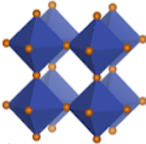Abstract
Bismuth trihalides, BiX3 (X = F, Cl, Br, and I), have been thrust into prominence recently because of their close chemical relationship to the halide perovskites of lead, which exhibit remarkable performance as active layers in photovoltaic cells and other optoelectronic devices. In the present work, we have used calculations based on density functional theory to explore the energetics and electronic properties of BiX3 in a variety of known and hypothetical structure types. The results for BiX3 are compared with those obtained for the halides of the later rare earths, represented by YX3 and LuX3. The relative thermodynamic stabilities of the known and hypothetical structures are calculated, along with their band gaps. For the BiX3 systems, we have explored the role of lone-pair effects associated with bismuth(III), and for BiI3, we have compared the predicted structural behavior as a function of pressure with the available experimental data. We have also attempted to synthesize LuF3 in the perovskite-related ReO3-type structure, which is predicted to be only ∼7.7 kJ mol−1 above the convex hull. This attempt was unsuccessful but led to the discovery of a new hydrated phase, (H3O)Lu3F10H2O, which is isomorphous with the known ytterbium analogue.
